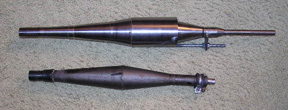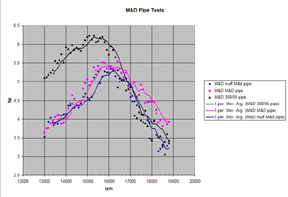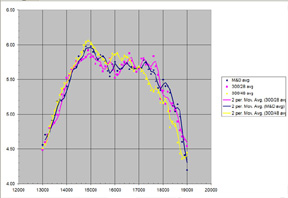
Beyond the basics...
***This article is reprinted from the September 2006 NAMBA Propwash with permission from the author and NAMBA. The entire newsletter can be found at www.namba.com.
Tuned pipes are an essential part of our two stroke engines. Without them engines would produce ½ their current power, or less. The Dooling 60 of the 1950s with cross flow scavenging and open exhaust put out around 1 hp at 10,000 rpm. These days a racing 67 puts out over 4 hp at 22,000 rpm. Improvements in scavenging from cross flow to Schnerle scavenging systems and their interactions with the tuned pipe are responsible for this huge improvement. Walter Kaaden and Erns Degner from Germany realized the pulsating nature of flow in two stroke engines and greatly improved the power of motorcycle engines in the late 1950s and early 1960s. Around that time Suzuki produced 50cc two-cylinder racing engines that produced about 20 hp at 20,000 rpm. Roger Theobald and Bill Wisniewski applied these principles to model engines, winning the 1964 FAI World Control Line Speed Championships. Bill later was responsible for the design K&B’s high output marine and ducted fan engines.
The tuned pipe acts as a no moving parts turbo charger. First the pipe uses the exhaust pulse produced in the time from exhaust opening to transfer opening to create a low pressure at the exhaust port. This draws fresh air and fuel mixture into the cylinder through the transfers while the piston is near bottom dead center. Second, the pipe creates a high-pressure pulse that arrives at the exhaust port in the interval between transfer port and exhaust port closing. This, in effect, supercharges the engine. These pulses are sound waves, not exhaust gas flows, and the pipe works much like a wind musical instrument.
 There are two main parts of the pipe that produce these pulses. The section that creates the low-pressure pulse is called the diffuser. This is the part of the pipe that starts at the piston and increases in diameter much like a megaphone or trumpet. The high-pressure pulse from the exhaust port opening is expanded in the diffuser, reducing its pressure, and a low-pressure wave, or “suction” pulse, is reflected back to the exhaust port. The exhaust pulse continues on to the converging or baffle cone where it’s pressure increases and a high-pressure pulse is reflected back to the exhaust port. The length and position of these two sections determines the time these reflected pulses, traveling at the speed of sound, arrive back at the exhaust port.
There are two main parts of the pipe that produce these pulses. The section that creates the low-pressure pulse is called the diffuser. This is the part of the pipe that starts at the piston and increases in diameter much like a megaphone or trumpet. The high-pressure pulse from the exhaust port opening is expanded in the diffuser, reducing its pressure, and a low-pressure wave, or “suction” pulse, is reflected back to the exhaust port. The exhaust pulse continues on to the converging or baffle cone where it’s pressure increases and a high-pressure pulse is reflected back to the exhaust port. The length and position of these two sections determines the time these reflected pulses, traveling at the speed of sound, arrive back at the exhaust port. Tuned pipe design is largely empirical. All the computer pipe design programs represent the collected experience of pipe designers and not basic laws of physics. They start with the length time the ports are open and the time it takes a pulse to travel up and down the pipe at the speed of sound in the exhaust gasses. An excellent free program for pipe design can be downloaded at http://www.iwt.com.au/pipedsn.HTM . A similar free program for simpler pipes can be found at http://www.mh-aerotools.de/airfoils/javapipe_en.htm. The basic program for pipes that doesn’t make any assumptions for you comes with the book Design and Simulation of Two-Stroke Engines by Gordon Blair. The hard part about all of these programs is understanding how the pipe really works and what parameters to plug in. The Blair program gives you the most freedom and that makes it the hardest to use for pipe design without experience as a guide.
The variables that need to be supplied by the designer beyond the mechanical dimensions of the engine are the average exhaust gas temperature, the design tuned rpm, the mid-section diameter and the horn coefficient. Exhaust gas temperature depends on the specific power of the engine. For our gasoline-powered engines I have measured it at around 400 to 450 degrees Centigrade. It should be cooler (around 400 degrees Centigrade) for nitro engines. Water injection can be used to lower this temperature and “lengthen” the pipe. Don’t get carried away with designing the pipe for high rpm. The idea is to have a power band that the pipe works in. I find that an rpm toward the beginning of this power band is a good starting point. The mid-section diameter is also a judgment call. As a rule, it can be somewhere between 2 and 3 ¼ times the minimum header diameter. The larger the diameter, the bigger the suction pulse. However, there is a limit to how big you can go.
The horn coefficient governs the shape of the diffuser. Early experimenters using simple, cone shaped diffusers noticed that diffusers with total cone angles of about 8 degrees worked well as reported by Gordon Jennings in his book, Two-stroke Tuner’s Handbook. Larger angles produced shorter, stronger suction pulses, while smaller angles produced longer, weaker suction pulses. There is also a limit to how much a simple diffuser can expand the exhaust pulse. The recommended belly diameter was about 2 ½ times the header minimum diameter for a single-cone diffuser. Adding stages with increasing angles allowed the diffuser to expand the exhaust pulse more and produced a series of low-pressure waves. The horn coefficient defines how rapidly these sections increase in angle. If you think of a trumpet, the horn coefficient determines how flared the horn is. A horn coefficient of 1.25 gives broad, lower strength suction pulses, while a horn coefficient of 2 gives steep, short, high strength suction pulses. Somewhere around 1.4 to 1.8 seems best. The baffle cone is usually a single cone for our engines. Two cone baffles are used, however on larger engines. Jennings also reports that a total baffle cone angle of 20 degrees produces a sharp, short pressure pulse; while an angle of 14 degrees produces a more broad, but weaker pulse.


So how do these things affect real engines? I have extensive dynamometer tests on two pipes for Zenoah engines. One is a conventional small diameter, two-cone design. The other is a large diameter design with a three-cone diffuser. This pipe was made with an adjustable center section to test the effect of various baffle cone positions relative to the diffuser. The single-cone diffuser has an angle of 12 degrees while the multi-cone diffuser has angles of 5.5, 11.3, and 21.2 degrees. The two-cone pipe has a baffle angle of 17 degrees while the multi-cone pipe has a baffle angle of 25.3 degrees. The bar graphs show the arrival times of the suction and pressure waves compared to the port open times at three different engine speeds for each pipe. The low rpm is 14,000 rpm, the middle rpm is 16,000 rpm and the high rpm is 18,000 rpm.
Notice that the single-cone diffuser generates a single suction pulse that more or less lines up with the period the transfers are open. Immediately following is the pressure pulse that arrives toward the time the transfers close. As the engine speed increases these pulses move to the right relative to the port open bars. At the lowest rpm the pressure pulse arrives too soon and finishes well before the exhaust port closes. At the highest rpm the suction pulse is still in the transfer open area and the pressure pulse is nearly ideally located in the area between transfer closing and exhaust closing. These graphs say nothing about the strength of these pulses; they only show relative arrival times compared to port open times. The pulse strength does show up on the engine power graph where the power is considerably less than that with the multi-cone pipe on the same engine. However, the rpm can be increased above 18,000 with this pipe and the pulses will still not be too far out of sync with the ports. This means that the double-cone pipe with relatively low angles has more “over rev” capacity than the more complex pipe.
The three-cone diffuser of the multi-cone pipe produces three suction pulses that cover the transfer open time better than the single pulse from the single-cone diffuser. The exhaust pulse also arrives at a good time. However, at 18,000 rpm the last suction pulse is starting to arrive after the transfers close. he exhaust pulse is also partly arriving after the exhaust port closes. Above 18,000 rpm this will get worse, limiting the power at higher rpm. ll of these pulses are considerably stronger due to the steeper angles and larger diameters of the multi-cone pipe. This shows on the power graph.
It all looks very simple, doesn’t it? Just get the right computer programs, plug in the right numbers and add ½ horsepower. However, look at the second horsepower graph. This is a comparison of the same two pipes on the same engine with one modification. The second set of graphs was taken on an engine that had its intake duration increased considerably. The two tests marked 300/48 and 300/28 represent the multi-cone pipe with either a 48mm or 28mm center section length. Now the high suction capability of the multi-cone pipe is wasted because the intake restriction is much less. It still gains a little at low rpm, but the giant improvement is gone. Only engine simulation programs would predict this result, and I have found that MOTA, one of the more affordable ones, doesn’t correlate well with dyno tests on our small engines. Other programs, especially the more expensive ones, might work better.
Lots of tests were done to determine the best center section length, stinger diameter, and whether an internal stinger was better than an external stinger. A somewhat shorter center section than the program predicted worked best, and an internal stinger, where the stinger extends into the pipe for the full baffle cone length works slightly better than the same stinger reversed in the conventional position.
The stinger diameter and length acts as a restriction in the exhaust, increasing the average pressure in the pipe. More pressure means more supercharge, but too much pressure worsens scavenging, causes overheating, and reduces power. Small diameter changes cause big pressure changes while length changes are much less effective. Doubling or halving the stinger length causes a barely noticeable power change. There may also be a small pressure wave generated by the stinger, but it is usually ignored. The moral of all this is that there may be big improvements in power from tuned pipe design. There may also be big improvements from porting changes with a given pipe. They all work together. An understanding of the basic principles combined with lots of testing is the only way to improve your engine.

